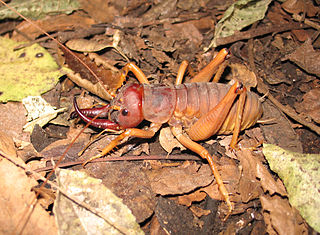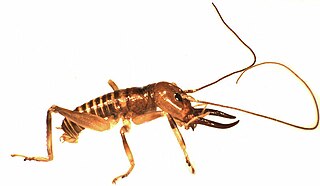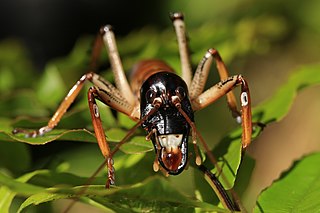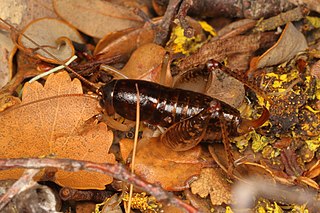
Anostostomatidae is a family of insects in the order Orthoptera, widely distributed in the southern hemisphere. It is named Mimnermidae or Henicidae in some taxonomies, and common names include king crickets in Australia and South Africa, and wētā in New Zealand. Prominent members include the Parktown prawn of South Africa, and the giant wētā of New Zealand.

Giant wētā are several species of wētā in the genus Deinacrida of the family Anostostomatidae. Giant wētā are endemic to New Zealand and all but one species are protected by law because they are considered at risk of extinction.

Motuweta is a genus consisting of two species of tusked wētā in the family Anostostomatidae, endemic to New Zealand. The Northland tusked wētā, Anisoura nicobarica, may belong in this group, in which case the genus Motuweta would become a junior synonym of Anisoura.

Hemiandrus is a genus of wētā in the family Anostostomatidae. In New Zealand they are known as ground wētā due to their burrowing lifestyle. Hemiandrus wētā are nocturnal, and reside in these burrows during the day. Ground wētā seal the entrance of their burrow during the day with a soil plug or door so that their burrow is concealed. Ground wētā adults are smaller than other types of wētā, with the unusual trait of having either long or short ovipositors, depending on the species. The name of this genus comes from this trait as hemi- mean half and -andrus means male, as the species where the female has a short ovipositor can sometimes be mistaken for a male. This genus has a diverse diet, depending on the species.

The Northland tusked wētā, Anisoura nicobarica, is a rare monotypic wētā of the family Anostostomatidae, endemic to the northern half of Northland in New Zealand, and originally described in 1932. The type specimen was wrongly labelled as coming from the Nicobar Islands, so the species was named Anisoura nicobarica. It was erroneously described again in 1950 by a different author, who placed it in the ground wētā genus Hemiandrus.

Deinacrida heteracantha, also known as the Little Barrier giant wētā or wētāpunga, is a wētā in the order Orthoptera and family Anostostomatidae. It is endemic to New Zealand, where it survived only on Hauturu. This very large flightless wētā mainly feeds at night, when it can be found above ground in vegetation. It has been classified as vulnerable by the IUCN due to ongoing population declines and restricted distribution. Its NZTCS threat classification was changed to "Threatened - Nationally increasing" in 2022 because it has been successfully translocated to 7 predator-free islands.

Deinacrida tibiospina, also known as the Mt Arthur giant wētā or the Nelson alpine giant wētā, is a species of wētā in the family Anostostomatidae. It is endemic to the South Island of New Zealand. The wētā is only found in some alpine zones of Kahurangi National Park. Compared with natural densities of other wētā, D. tibiospina is fairly rare. Little conservation effort has been made for this species because, despite its elusiveness, populations on the mainland have been maintained without human intervention.
Kjell Ernst Viktor Ander was a Swedish entomologist. Ander was admitted as Doctor of Philosophy at Lund University in 1939. Ander worked as a docent at Lund University from 1937 to 1951.

Hemideina thoracica, commonly known as the Auckland tree wētā or tokoriro is a cricket-like insect. It is endemic to New Zealand and is found over most of the North Island, except for the Wellington region and regions 900 metres above sea level. This species is an arboreal, herbivorous generalist however, it is also thought to be polyphagous and is found in all wooded habitats, including forest, scrub and suburban gardens.

Hemideina maori, also known as the mountain stone wētā, is a wētā of the family Anostostomatidae. They are a large, flightless, nocturnal orthopteran endemic to New Zealand. Mountain stone wētā are long lived and are found on many central mountain ranges in New Zealand's South Island.

Hemideina crassidens, commonly known as the Wellington tree wētā, is a large, flightless, nocturnal insect in the family Anostostomatidae. This wētā species is endemic to New Zealand and populates regions in the southern half of North Island/Te Ika a Maui and the north-west of the South Island/Te Wai Pounamu. They forage arboreally during the night and are most likely polyphagous. There is obvious sexual dimorphism in adults. Individuals are reliant on tree cavities for refuge, social interactions and mating.

Hemiandrus electra, the Kahurangi ground wētā, is a species of ground wētā endemic to New Zealand. Being a ground wētā, they are often found in burrows in the ground during the daytime. The species is occurs on the South Island and is classified as "Naturally Uncommon". This species of wētā is unusual for an insect in that the female looks after her eggs and nymphs; this is known as maternal care.

Hemiandrus bilobatus, the wine wētā, is a species of ground weta endemic to New Zealand. Being a ground weta, they are often found in burrows in the ground during the daytime. The species is found in Wellington, on Mana Island and northern South Island and is classified as "Not Threatened". This species of weta is unusual for an insect in that the female shows maternal care. She lays about 50 eggs in the same burrow she uses during the day and looks after her eggs until they hatch.

Anderus nox, the night ground wētā, is a species of ground wētā endemic to New Zealand. During the day, this wētā hides in burrows in the soil and is active only at night. The species is found in native forests in North and South Island. Females of this species have medium-long curved ovipositers to lay their eggs in the soil. Unlike some ground wētā species, A. nox does not show maternal care.

Mary Morgan-Richards is a New Zealand biologist, and as of 2019 is a full professor at Massey University.

Anderus maculifrons is a species of ground wētā endemic to New Zealand. They are nocturnal, carnivorous, and flightless orthopterans belonging to the family Anostostomatidae. Being a nocturnal species, individuals remain in tunnels in the ground during the day and emerge from their burrows after sunset to forage and hunt for small invertebrates. Anderus maculifrons is one of the smallest New Zealand weta species, averaging 15 mm in length and weighing 1–3 g. Unlike the tree weta and tusked weta, where sexual dimorphism is found in the form of male weaponry, ground weta only exhibit sexual size dimorphism: the females are larger than the males.

Wētā is the common name for a group of about 100 insect species in the families Anostostomatidae and Rhaphidophoridae endemic to New Zealand. They are giant flightless crickets, and some are among the heaviest insects in the world. Generally nocturnal, most small species are carnivores and scavengers while the larger species are herbivorous. Although some endemic birds likely prey on them, wētā are disproportionately preyed upon by introduced mammals, and some species are now critically endangered.

Hemiandrus focalis is a species of ground wētā endemic to New Zealand. This flightless Orthoptera lives in the mountains of the South Island, New Zealand. This species can be distinguished from other ground wētā by their three superior retrolateral spines on their mid tibia and females have relatively long ovipositors. This omnivorous ground wētā species is listed as "not threatened" by the New Zealand Department of Conservation.

Anderus brucei is a species of ground wētā in the family Anostostomatidae endemic to New Zealand. These insects are nocturnal and found in forests in the North Island and northern South Island.

Anderus is a genus of forest insects in the family Anostostomatidae (wētā). All Anderus species are nocturnal, and hide in burrows during the day. In New Zealand they are known as ground wētā due to their burrowing lifestyle. Ground wētā adults are smaller than other types of wētā, and females of all Anderus species have long ovipositors.



















